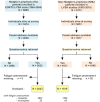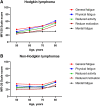Fatigue level changes with time in long-term Hodgkin and non-Hodgkin lymphoma survivors: a joint EORTC-LYSA cross-sectional study
- PMID: 31266501
- PMCID: PMC6604328
- DOI: 10.1186/s12955-019-1186-x
Fatigue level changes with time in long-term Hodgkin and non-Hodgkin lymphoma survivors: a joint EORTC-LYSA cross-sectional study
Abstract
Background: Long-term lymphoma survivors often complain of persistent fatigue that remains unexplained. While largely reported in Hodgkin lymphoma (HL), long-term fatigue is poorly documented in non-Hodgkin lymphomas (NHL). Data collected in two cohort studies were used to illustrate the fatigue level changes with time in the two populations.
Methods: Two cross-sectional studies were conducted in 2009-2010 (HL) and in 2015 (NHL) in survivors enrolled in European Organisation for Research and Treatment of Cancer (EORTC) Lymphoma Group and Lymphoma Study Association (LYSA) trials. The same protocol and questionnaires were used in both studies including the Multidimensional Fatigue Inventory (MFI) tool to assess fatigue and a checklist of health disorders. Multivariate linear regression models were used in the two populations separately to assess the influence of time since diagnosis and primary treatment, age, gender, education level, cohabitation status, obesity and health disorders on fatigue level changes. Fatigue level changes were compared to general population data.
Results: Overall, data of 2023 HL and 1619 NHL survivors with fatigue assessment available (99 and 97% of cases, respectively) were analyzed. Crude levels of fatigue were similar in the two populations. Individuals who reported health disorders (61% of HL and 64% of NHL) displayed higher levels of fatigue than those who did not (P < 0.001). HL survivors showed increasing fatigue level with age while in NHL survivors mean fatigue level remained constant until age 70 and increased beyond. HL survivors showed fatigue changes with age higher than those of the general population with health disorders while NHL survivors were in between those of the general population with and without health disorders.
Conclusions: Among lymphoma survivors progressive increase of fatigue level with time since treatment completion is a distinctive feature of HL. Our data suggest that changes in fatigue level are unlikely to only depend on treatment complications and health disorders. Investigations should be undertaken to identify which factors including biologic mechanisms could explain why a substantial proportion of survivors develop high level of fatigue.
Keywords: Cross-sectional study; Fatigue; Hodgkin lymphoma; Long-term survivors; Non-Hodgkin lymphomas.
Conflict of interest statement
The authors declare that they have no competing interests.
Figures



 ) and non-Hodgkin lymphomas (
) and non-Hodgkin lymphomas ( ) low educated males survivors, living alone, treated at 45 years of age. Predicted mean fatigue scores for general population (dash lines) with (▲) and without (▼) health disorders [17]
) low educated males survivors, living alone, treated at 45 years of age. Predicted mean fatigue scores for general population (dash lines) with (▲) and without (▼) health disorders [17]References
-
- Ben Diane MK, Bouhnik AD, Foucaud J, Préau M. La fatigue. In: Institut National du Cancer, editor. La vie cinq ans après un diagnostic de cancer. Boulogne-Billancourt: INCa; 2018. pp. 92–103.
-
- Heutte N, Flechtner HH, Mounier N, Mellink WA, Meerwaldt JH, Eghbali H, et al. Quality of life after successful treatment of early-stage Hodgkin’s lymphoma: 10-year follow-up of the EORTC-GELA H8 randomised controlled trial. Lancet Oncol. 2009;10:1160–1170. doi: 10.1016/S1470-2045(09)70258-X. - DOI - PubMed
MeSH terms
Grants and funding
LinkOut - more resources
Full Text Sources
Medical

